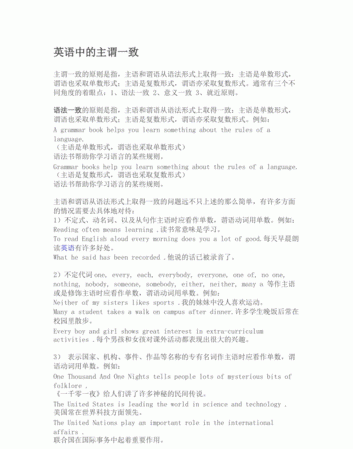本文目录
英语主谓一致三大原则
英语主谓一致使用原则
导语:主谓一致即谓语动词在人称和数上要和主语保持一致,下面我分享英语主谓一致使用原则,欢迎参考!

在英语中,句子的主语和谓语动词在人称和数上必须保持一致,并且大致遵循以下三个原则:
1. 就近一致原则
即句子的谓语动词同最近的主语在人称和数上保持一致。如:
Not you but I am to blame. 不是你而是我应该受责。
Not only you but also your teacher is supposed to go. 不仅你要去,而且你的老师也要去。
2. 语法一致原则
即谓语动词与主语在语法形式上保持一致,即主语是单数形式,动词用单数形式,主语是复数形式,动词用复数形式。如:
The girls are busy packing. 姑娘们在忙着收拾东西。
The last few winters have been very cold. 过去几个冬天都很冷。
Many a student has seen the film. 许多学生看过这部电影。
3. 意义一致原则
即谓语动词的数取决于主语所表示的意义,而不是其语法形式。如:
People are lying on the beach. 人们躺在海滩上。
The steel works is closed for the holidays. 钢厂因放假关门了。
和主语必须在人称和数上保持一致,最基本的原则是:单数主语用单数动词,复数主语用复数动词.但在实际使用当中情况比较复杂,现在学生常犯的主谓一致错误归纳整理如下:
1,"more than one +名词"作主语时,谓语动词常用单数.例如:
More than one teacher gets the flowers. 不止一个教师得到了花.
2,"many a +名词"作主语时,从意义上看是复数,但谓语动词常用单数.例如:
Many a student has been sent to plant trees. 很多学生被派去植树.
3,"half of,the rest of,most of,all of及百分数或分数+of 等后接名词"作主语时,谓语动词形式根据of后的名词而定.例如:
Three fourths of the surface of the earth is covered with water.地球表面四分之三为水所覆盖.
4,all指人时,动词用复数;all指物时,动词用单数.例如:
"All are present and all is going well." 所有人全部到场了,一切进展顺利
5,what引导的主语从句,谓语动词可视表语而定:表语是单数名词时,动词用单数,相反,则用复数.例如:
What they want to get are a number of good books.他们想得到的是大量的好书.
6,and连接的两个单数名词前若用each,every,no修饰,该名词短语作主语时,谓语动词用单数形式.例如:
No book and no pen is found in the schoolbag.书包里没有书和钢笔.
7,当主语后面有as well as,with,along with,together with,but,like,rather than,except,逗号加and连接几个名词等引导的短语时,谓语动词要与最前面的'主语保持一致.例如:
My father as well as his workmates has been to Beijing. 我父亲和他的同事曾去过北京.
8,each作主语的同位语时,谓语动词由主语来决定,与each无关.例如:
They each have a bike. 他们每人有一辆自行车.
9,动词不定式,动词-ing形式短语作主语时,谓语动词常用单数.例如:
Going out for a walk after supper is a good habit.晚饭后出去散步是一个好习惯.
10,the following作主语时,谓语动词的数与后面名词的数保持一致.例如:
The following are good examples
;主谓一致的各种情况及例句英语
一般情况下,主谓之间的一致关系由以下三个原则的支配: 语法一致原则、 意义一致原则和就近原则。
一、语法一致
主谓一致的原则是指主语和谓语从语法形式上取得一致:主语是单数形式,谓语也采取单数形式;主语是复数形式,谓语亦采取复数形式。例如:
He often helps me learn English. (主语是单数形式,谓语也采取单数形式) 。
My friends often help me learn English. (主语是复数形式,谓语也采取复数形式)
但主语和谓语从语法形式上取得一致的问题远不只上述的那么简单,有许多方面的情况需要去具体地对待:
1、不定式,动名词,以及从句作主语时应看作单数,谓语动词用单数。
例如:Reading aloud is helpful to learn English.大声朗读对学习英语是有帮助的。
What he said has been recorded .他说的话已被录音了。
2、不定代词one, every, each, everybody, everyone, one of, no one, nothing, nobody, someone, somebody, either, neither, many a 等作主语或是修饰主语时应看作单数,谓语动词用单数。但none 作主语时,谓语动词既可用单数也可用复数,这要取决于说话人的看法。
例如:Neither of my sisters likes sports .我的妹妹中没人喜欢运动。
Every boy and girl shows great interest in this book .每个男孩和女孩对这本书都表现出很大的兴趣。
3、表示国家,机构,事件,作品等名称的专有名词作主语时应看作单数,谓语动词用单数。
例如:One Thousand And One Nights tells people lots of interesting stories . 《一千零一夜》给人们讲了许多有趣的故事。
4、a kind of, the number of等与名词构成名词短语作主语时应看作单数,谓语动词用单数。
例如:The number of workers in the factory is 400. 这个工厂里工人的数量是400.
A kind of rose in the garden smells very pleasant.这座花园里有一种玫瑰香气怡人。
5、由some, several, both, few, many, a number of 等词修饰主语,或是由它们自身作主语时应看作复数,谓语动词用复数。另外,由and连接两个主语时,谓语一般用复数。
例如:On the seashore, some people are playing volleyball 海边,有些人在打排球。
Both of us are fond of watching football games .我们俩都喜欢看足球赛。
A number of will-be graduates are voluntarily going to work in the West of China. 许多即将毕业的学生打算自愿去中国西部工作。
6、有些表示数量的百分数,分数等后面加名词或代词作主语时,要根据这个名词或代词来决定其谓语动词的单复数形式。如:a lot of, most of, any of, half of, three fifths of, eighty percent of, some of, none of, the rest of , all of等后接不可数名词,或是单数形式的名词作主语时应看作单数,谓语动词用单数;但如果后接可数名词的复数形式作主语时应看作复数,谓语动词用复数。
例如:A lot of money in the shop was stolen yesterday. 昨天那家商店丢失了许多钱。
A lot of students are from England in the school.那个学校里很多学生来自英国。
二、意义一致
这一原则是指,从意义着眼来解决主谓一致问题。有时主语形式上为单数,但意义上却是复数,那么谓语依意义也用复数形式;而有时主语形式上为复数,但意义上却是单数,那么谓语依意义亦用单数形式。
1)当主语后面接由but, except, besides, as well as, as much as, including, more than, no less than, rather than, together with等引导的词组时,其谓语动词的单复数形式通常由前面的词来决定。在这样的句子里,这些词所引导的词组不影响主语自身的单,复数形式,它们在句子里其实是状语。
例如:The teacher, with all his students, is going to have a picnic this weekend.老师打算这个周末与学生们一起去野炊。
The students, together with their teacher, are going to have a picnic this weekend.学生们打算这个周末与他们的老师一起去野炊。
我们完全可以将上面句子中的那些词组都分别搬到句首或是放到句末去,因为它们在句子里是状语:The students are going to have a picnic this weekend together with their teacher.
2)表示时间,金钱,距离,体积,重量,面积,数字等词语作主语时,谓语动词常用单数形式。如:
Eight hours of sleep is enough. 八小时的睡眠足够了。
Twenty years stands for a long period in one's life. 二十年在人的一生里意味着一个很长的时期。
3)形容词前加定冠词即“the + 形容词”作主语时,其意义若是指个人或是抽象概念应看作单数,谓语动词用单数;指一类人则应该看作是复数,那么谓语动词也应该用复数。
例如:The sick here are very well cared for. 这里的病人都被照顾得很好。
The true is to be distinguished from the false. 真实与虚假应加以区别。
4)由and 连接的两个单数名词作主语时,谓语动词一般根据语法一致的原则用复数。
但如果在意义上指同一个人、同一件事或同一个概念时,谓语动词要用单数形式。
如:The writer and teacher is coming. 那位作家兼教师来了。(作家和教师指同一个人)
The writer and the teacher are coming. 作家和老师来了。(作家和老师是两个人)
5)集体名词作主语时,谓语动词的数取决于主语的意义:主语表示整体时视为单数,谓语动词用单数;主语表示集体中的个体成员时视为复数,谓语动词用复数。这类集体名词常见的有:army, class, club, crowd, family, government, group, people, police, public, team等。
例如:The family are all fond of football. 那一家人都喜欢足球。
The family is the tiniest cell of the society. 家庭是社会的最小的细胞。
6)一些形式为复数,意思为单数的名词,如:trousers, pants, shorts, glasses, 等作主语时,谓语动词用复数。
如:Her glasses are new. 她的眼镜是新的。
但当这类名词前有a pair of 修饰时,谓语动词应用单数。
如:This pair of trousers is made in Hangzhou.
三、就近原则
这一原则是指,谓语动词的人称和数常常与最近作主语的词语保持一致。常出现在这类句子中的连词有:or, either… or …, neither… nor … , not only… but also …等。
例如: Either I or they are responsible for the result of the matter. 不是我,就是他们要对那件事的结局负责任。
Neither his family nor he knows anything about it. 他全家人和他都不知道那件事。

主谓一致 例句
1.人称、数的一致。 [2例句] I am a student . Two books are on the desk .2.不可数名词、不定代词表示抽象概念作主语时,谓语动词用单数。[1例句] there is little water in the bottle .3.主语为people , police,时,谓语动词用复数。[1例句] the police are searching the lost boy .4.集体名词family, class, team, group,等看作整体时,谓语动词用单数;看作每一个成员时,谓语动词用复数。[2例句] class four ins on the second floor. my family has moved to Beijing .5.与and连接的并列主语表示不同的人和物时,谓语动词用复数,表示一个概念时则用单数。[2例句] Tom and lilei are students. The artist and teacher is coming .6.主语是单数,后跟with,as well as, but ,except等介词短语时,谓语动词用单数。[1例句] Mr Green, together with his students is in the classroom.7.金钱、距离、时间、重量、长度等复数名词做主语,通常应当作整体看,谓语动词用单数。[1例句] Two days is not long.8.tousers、shoes、glasses等作主语,谓语动词用复数。[1例句] my tousers are on the desk .9.most of、 half of、 some of、 part of 、a lot of修饰名(代)词作主语时,谓语动词与of后面的名词或代词的数保持一致。[2例句]Half of the population are farmers. A lot of water is wasted.10.news, physics等词貌似复数,实为单数,作主语时,谓语动词用单数。[1例句]The news is true. 11.either… or… 与neither… nor,not only... but also...作主语时,谓语动词与离它们最近的名词或代词在人称和数上保持一致。[2例句] Not only he but also I am good at maths.Neither you nor he is going with him. 12there be 的谓语动词与离它们最近的名词或代词在人称和数上保持一致。[2例句] There is a pen ,two pencils and a book on the desk.There are two apples and a banana in the basket.

高中英语主谓一致语法总结
精讲高中英语主谓一致语法
在高中英语学习中,随着学习的不断深入,同学们会逐渐发现能够充当主语的成分也越来越多,除了常见的名词、代词,还有非谓语、句子等等,那么如何使这些主语和它的谓语动词保持性、数上的一致,即主谓一致就成了我们英语学习中的一个重要课题,也是历来高考题关注的热点。现总结主谓一致的`几点原则如下:

(1)就近原则
①由并列结构或连词(either…or, neither…nor,not…but, not only…but also, or等)连接的并列主语,谓语动词与靠近的那个名词或代词保持一致。
Neither his parents nor Tom is at home.
汤姆和他的父母都不在家。
注:either…or,neither…nor,or连接的两个主语若是一单一复,最好将复数主词放在后面而接复数动词。
②在倒装句和there be句型中,谓语动词与后面的第一个主语保持一致。
There is a book and some pens on the desk.
桌子上有一本书和几支钢笔。
There comes the bus.汽车来了。
③在定语从句中,关系代词作主语,其谓语动词应与它所指代的先行词保持一致。
I know the man who is talking to my father.
我认识那个正在和我父亲谈话的人。
④在强调句中,连接代词又在句中作主语,这时它应与被强调的主语保持一致。
It is Mary's brother who was injured in the car accident.
是玛丽的哥哥在车祸中受伤了。
(2)意义一致原则
①当主语与谓语动词之间插入along with,with,as well as,together with, no less than,besides,except, but, including等短语时,谓语动词不受这些插入语的干扰,依然和主语保持一致。
I,along with my sister,am going to Shanghai next month.
我,还有我姐姐,打算下个月去上海。
②英语中有一类单、复数同型的词(people,means,sheep,deer,fish等),其单、复数取决于它在句中的含义。
All of the people in the country have been prepared for the great reformation.
这个国家的人都已经为大变革作好了准备。
③多数情况下,由what引导的名词性从句作主语时,其后的谓语动词通常用单数形式。
What I want to say is just Take care!我只想说:多保重!
④当主语与all, none, any,some等不定代词、形容词连用时,应根据具体句意,来决定其后的谓语动词的单复数。
All I know about this company is what he told me yesterday.
我对这家公司的了解都是昨天他告诉我的。
;以上就是关于英语中主谓一致有but的句子,英语主谓一致三大原则的全部内容,以及英语中主谓一致有but的句子 的相关内容,希望能够帮到您。

